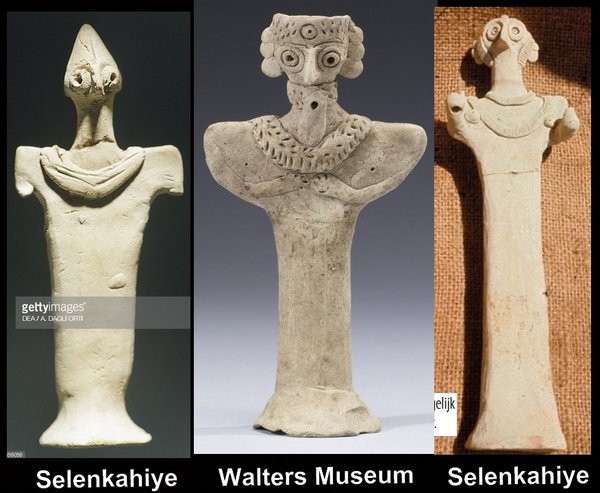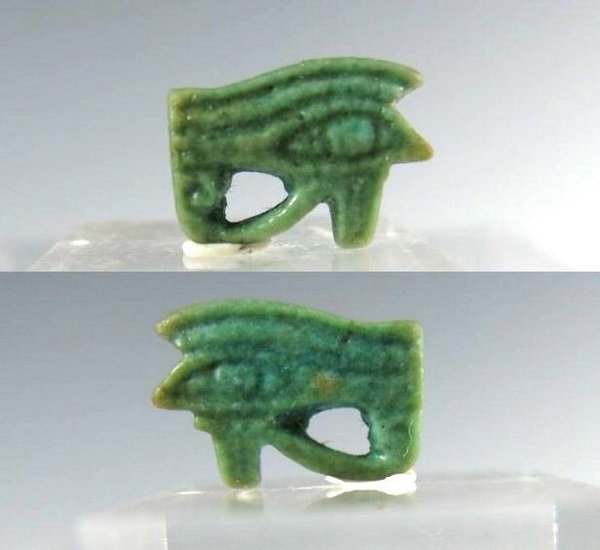
|
|

|
YOU ARE HERE:>>Collectors' Resources>>Essentials>>Researching your pieces page 4
From Franco
20th September 2007
With kind permission of Frnco Magnarini and Prof Alessandro Roccati of ![]() archaeogate: which I very much recommend you look at . This article appears on archaeogate in Italian.
archaeogate: which I very much recommend you look at . This article appears on archaeogate in Italian.
(Archaeogate was a very interesting a portal for Italian archaeologists which also published preliminary reports of Italian excavations.
Most of the contents were in Italian but many were in English and very useful to an international audience. Sadly this website closed down several years ago.)
It must be said that most of scarabs of Amenhotep I, son of Ahmose and the second king of 18th dynasty, are not contemporary with his reign. "The reason for this can be found in the worship of him and his mother Ahmose-Nefertari. This worship lasted throughout the New Kingdom and many of the scarabs we find with his name were made over a period of time in respect of this cult.
Probably the first king buried in the Valley of The Kings was his successor Tuthmosis I who is deemed the true founder of the village Deir el-Medina the community working an the graves in The Valley of The Kings . In fact the place of burial of Amenhotep I is disputed: some think he was buried at necropolis of Dra Abu el-Naga, (grave AN-B belonging to him or to his mother), others believe he was buried in the Kings Valley in grave KV35.
That being stated, the first problem presenting itself in the study of these scarabs is their dating 2.

This fine scarab is made in brownish steatite covered with a bright green glaze, partially lost on the base: dimensions. 20mm x 12,5mm x 8mm. On the very convex back, which is smooth, the pronotum is suggested by two diagonal notches, turned toward the rear . Low legs, superficially carved and fully notched. Classification is Tufnell 3 A7/O/d6. The engraving is superficial, level with precise contours and there are notched details inside some sign (red crowns).
The vertically arranged motifs are complex: under a median line is the prenomen of Amenhotep I, Djeserkara, placed upon the gold sign nwb and flanked by anx and nfr signs specularly arranged. Upon the median line, the Hs sign flanked by a pair of anx signs and by two red crowns more externally. At the top, the clump of papyrus HA upon a wide rectangular base.
The motifs recall to mind the "symmetric pattern"4 used during the SIP with repeated pairs of signs symmetrically arranged around a central motif; several times and with a line crossing the length 5. The most common signs in these symmetric patterns are anx, nfr, nwb, HA and red crowns which we find again in our item. Notice that the pronomen is written free in the field (without cartouche) and is proportionally small in respect of the whole design. In fact, often it is written with minute signs or with slanting, untidy and decentralized characters: human figures or animals 6, which oddly gives little emphasis to the name.
Another characteristic of scarabs of this king is that, of 52 parallels we have examined, the prenomen appears most often free in the field (75%) 7 than inscribed within a cartouche (25%) 8.
Secondly, notice that some signs are already emptied inside in the fashion they were from the NK onwards (red crown on the right and anx sign bottom left); others are still outlined as is seen in the Second Intermediate Period (nwb sign) and the HA sign has the characteristic wide base) 9.

On the whole, the type of engraving approaches that characteristic of the 18th dynasty: superficial, levelled with precise contours and some signs emptied inside 10.
The combination is of two types of engraving and the symmetric pattern and shape, more often used in the middle Kingdom and Second Intermediate Period. Humeral callosities ("V notches") do not yet appear on the elytra; – these generally come in at beginning of NK., These features make one think a period of transition: between Second Intermediate Period and the New Kigngdom IP NK, at the beginning of which is the reign of this king, Amenhotep I.
Probably, the craftsman at the beginning of 18th dynasty created this scarab adopting the innovative stylistic features of new epoch, but was still a little conditioned by old style used in Second intermediate Period..
This scarab can therefore be considered most probably contemporary with the reign of Amenhotep I (1526 BC -1506 BC.).
1 Jaeger B.,"ESSAI DE DATATION ET CLASSIFICATION DES SCARABEES MENKHEPERRE", § 1533 and foll.
2 The parallels quoted below unfortunately report almost always datings to XVIII dinasty, without quoting possible posthumous realisations.
3 Tufnell O., "STUDIES ON SCARAB SEALS" vol. 2, part 1 Warminster, UK - 1984, 32-37.
4 Tufnell O., "STUDIES ON SCARAB SEALS" vol. 2, part 1 Warminster, UK - 1984, p. 118.
5 Tufnell O., "STUDIES ON SCARAB SEALS" vol. 2, part 2 Warminster, UK - 1984, pl. X, 1513; pl.XII, 1556, 1560.
6 Flinder Petrie W.M., "HISTORICAL SCARABS", London, 1889, pl. 28, 816,820,821,824;
Flinders Petrie W.M., "SCARABS AND CYLINDERS WITH NAMES", London 1917, pl. XXIV, 18.2.3 (this in particular, has a similar motif, with same signs and the middle line)-4;
Hall H.R., "CATALOGUE", London 1913, 404,407,414,415,418;
Hornung E.-Staehlin E. "SKARABÄEN UND ANDERE SIEGELAMULETTE AUS BASLER SAMMLUNGEN" Basel, 1976,
p. 232, 206 = Fraser 195;
Matouk F.S., "CORPUS DU SCARABEE EGYPTIEN" tome 1°, Liban, 1971, p.183, 271b; p.208, 214;
Newberry P.E., "SCARABS...", London 1906, pl. XXVI, 24,25,27.
7 Flinder Petrie W.M., "HISTORICAL SCARABS", London, 1889, pl.27, 803,809,808; pl. 28, 814,816,820,821,824;
Flinders Petrie W.M., "SCARABS AND CYLINDERS WITH NAMES", London 1917, pl. XXIV, 18.2.3-4-6-7-8-9-16;
Hall H.R., "CATALOGUE", London 1913, 395,396,397,399,400,404,407,409,414,415,418,420;
Hodjash S., "ANCIENT EGYPTIAN SCARABS" Moscow, 1999, pl. 3,48,49;
Hornung E.-Staehlin E. "SKARABÄEN UND ANDERE SIEGELAMULETTE AUS BASLER SAMMLUNGEN" Basel, 1976,
p. 232, 206 (= Fraser 195), 207,208;
Matouk F.S., "CORPUS DU SCARABEE EGYPTIEN" tome 1°, Liban, 1971, p.183, 271; p.208, 213,214;
Newberry P.E., "SCARABS...", London 1906, pl. XXVI, 24,25,27,33.
8 Flinder Petrie W.M., "HISTORICAL SCARABS", London, 1889, pl. 817,819,822,823;
Flinders Petrie W.M., "SCARABS AND CYLINDERS WITH NAMES", London 1917, pl. XXIV.18.2.5;
Hall H.R., "CATALOGUE", London 1913, 405,413;
Hodjash S., "ANCIENT EGYPTIAN SCARABS" Moscow, 1999, pl. 3,47;
Matouk F.S., "CORPUS DU SCARABEE EGYPTIEN" tome 1°, Liban, 1971, p.183,271b; 208,212;
Newberry P.E., "SCARABS...", London 1906, pl. XXVI, 23,26,28.
9 Vedi Hall H.R., "CATALOGUE", London 1913, 300.
10 Jaeger B.,"ESSAI DE DATATION ET CLASSIFICATION DES SCARABEES MENKHEPERRE", § 1071.


Home | About This Site | Privacy Statement | Gallery | Testimonials | Guarantees
About Collectors' Resources pages | What's New
Search | Site Map | Contact Us